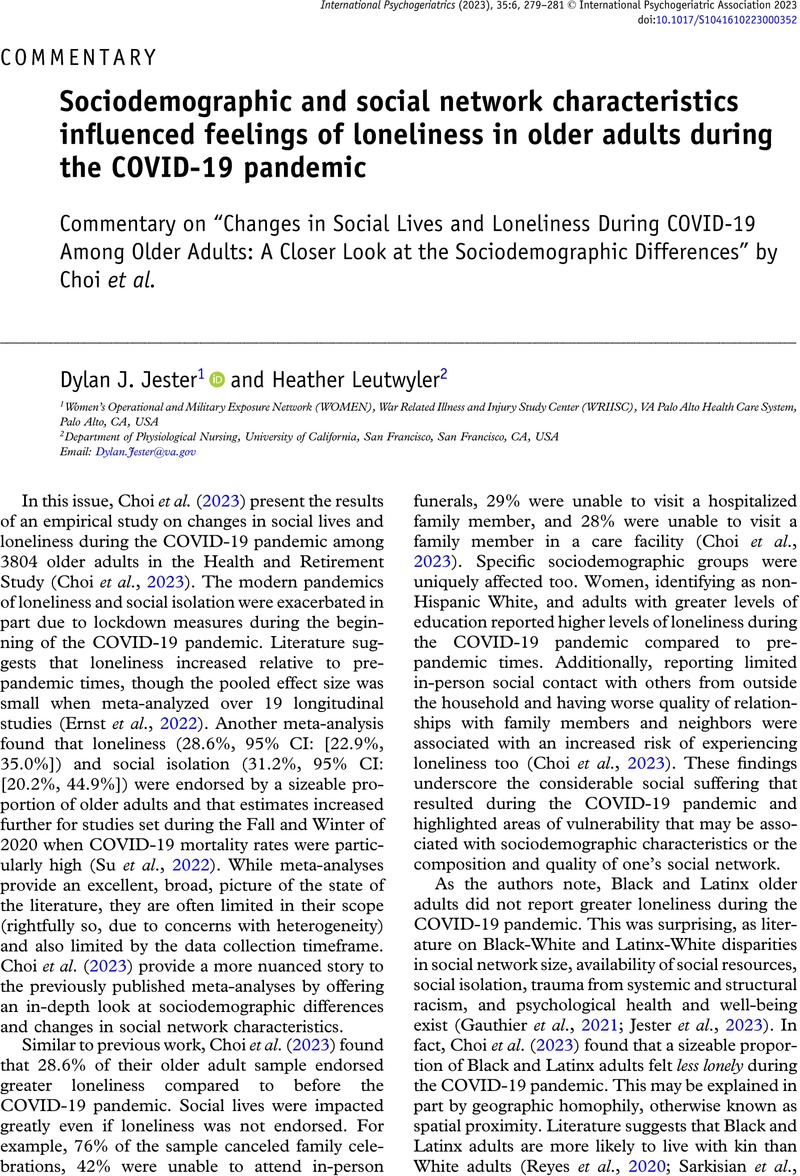No CrossRef data available.
Article contents
Sociodemographic and social network characteristics influenced feelings of loneliness in older adults during the COVID-19 pandemic
Commentary on “Changes in Social Lives and Loneliness During COVID-19 Among Older Adults: A Closer Look at the Sociodemographic Differences” by Choi et al.
Published online by Cambridge University Press: 13 April 2023
Abstract
An abstract is not available for this content so a preview has been provided. Please use the Get access link above for information on how to access this content.

- Type
- Commentary
- Information
- International Psychogeriatrics , Volume 35 , Special Issue 6: Issue Theme: Loneliness in Older Adults , June 2023 , pp. 279 - 281
- Copyright
- © International Psychogeriatric Association 2023
References
Choi, E. Y., Farina, M. P., Zhao, E. and Ailshire, J. (2023). Changes in social lives and loneliness during COVID-19 among older adults: a closer look at the sociodemographic differences. International Psychogeriatrics, 35, 305–317. https://doi.org/10.1017/S1041610222001107
CrossRefGoogle Scholar
Cohen-Mansfield, J., Hazan, H., Lerman, Y. and Shalom, V. (2016). Correlates and predictors of loneliness in older-adults: a review of quantitative results informed by qualitative insights. International Psychogeriatrics, 28, 557–576.CrossRefGoogle ScholarPubMed
Ernst, M. et al. (2022). Loneliness before and during the COVID-19 pandemic: a systematic review with meta-analysis. American Psychologist, 77, 660–677.CrossRefGoogle ScholarPubMed
Gauthier, G. R., Smith, J. A., García, C., Garcia, M. A. and Thomas, P. A. (2021). Exacerbating inequalities: social networks, racial/ethnic disparities, and the COVID-19 pandemic in the United States. The Journals of Gerontology: Series B, 76, e88–e92.CrossRefGoogle ScholarPubMed
Gorczynski, P. and Fasoli, F. (2022). Loneliness in sexual minority and heterosexual individuals: a comparative meta-analysis. Journal of Gay & Lesbian Mental Health, 26, 112–129.CrossRefGoogle Scholar
Goveas, J. S. et al. (2022). Associations between changes in loneliness and social connections, and mental health during the COVID-19 pandemic: The Women’s Health Initiative. The Journals of Gerontology: Series A, 77, S31–S41.CrossRefGoogle ScholarPubMed
Halladay, J. R. et al. (2017). Community advisory boards guiding engaged research efforts within a clinical translational sciences award: key contextual factors explored. Progress in Community Health Partnerships: Research, Education, and Action, 11, 367–377.CrossRefGoogle ScholarPubMed
Hanes, D. W. and Clouston, S. A. (2021). Ask again: including gender identity in longitudinal studies of aging. The Gerontologist, 61, 640–649.CrossRefGoogle ScholarPubMed
Jester, D. J. et al. (2023). Review of major social determinants of health in schizophrenia-spectrum psychotic disorders: I. Clinical outcomes. Schizophrenia Bulletin, 1–14. https://doi.org/10.1093/schbul/sbad023
CrossRefGoogle ScholarPubMed
Jester, D. J. et al. (2023). Differences in social determinants of health underlie racial/ethnic disparities in psychological health and well-being. The American Journal of Psychiatry, 1–12. https://doi.org/10.1176/appi.ajp.20220158
CrossRefGoogle ScholarPubMed
Maes, M., Qualter, P., Vanhalst, J., Van den Noortgate, W. and Goossens, L. (2019). Gender differences in loneliness across the lifespan: a meta-analysis. European Journal of Personality, 33, 642–654.CrossRefGoogle Scholar
Ojembe, B. U. et al. (2022). Understanding social and emotional loneliness among black older adults: a scoping review. Journal of Applied Gerontology, 41, 2594–2608.CrossRefGoogle ScholarPubMed
Reyes, A., Schoeni, R. F. and Choi, H. (2020). Race/ethnic differences in spatial distance between adult children and their mothers. Journal of Marriage and Family, 82, 810–821.CrossRefGoogle ScholarPubMed
Rossen, L. M. et al. (2021). Disparities in excess mortality associated with COVID-19—United States, 2020. MMWR. Morbidity and Mortality Weekly Report, 70, 1114–1119.CrossRefGoogle Scholar
Sarkisian, N., Gerena, M. and Gerstel, N. (2007). Extended family integration among Euro and Mexican Americans: ethnicity, gender, and class. Journal of Marriage and Family, 69, 40–54.CrossRefGoogle Scholar
Smith, J. A., McPherson, M. and Smith-Lovin, L. (2014). Social distance in the United States: sex, race, religion, age, and education homophily among confidants, 1985 to 2004. American Sociological Review, 79, 432–456.CrossRefGoogle Scholar
Su, Y., Rao, W., Li, M., Caron, G., D’Arcy, C. and Meng, X. (2022). Prevalence of loneliness and social isolation among older adults during the COVID-19 pandemic: A systematic review and meta-analysis. International Psychogeriatrics, 1–13. https://doi.org/10.1017/S1041610222000199
Google ScholarPubMed
Tibiriçá, L., Jester, D. J. and Jeste, D. V. (2022). A systematic review of loneliness and social isolation among Hispanic/Latinx older adults in the United States. Psychiatry Research, 313, 1–12.CrossRefGoogle ScholarPubMed
Webber-Ritchey, K. J. et al. (2021). Recruitment strategies to optimize participation by diverse populations. Nursing Science Quarterly, 34, 235–243.CrossRefGoogle ScholarPubMed
Wickens, C. M. et al. (2021). Loneliness in the COVID-19 pandemic: associations with age, gender and their interaction. Journal of Psychiatric Research, 136, 103–108.CrossRefGoogle ScholarPubMed




